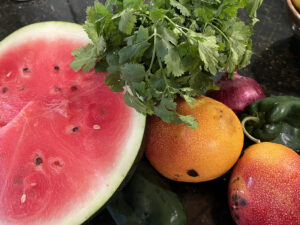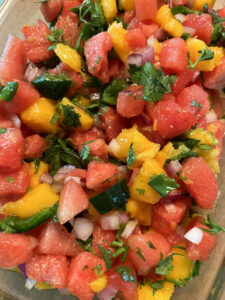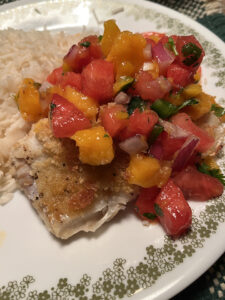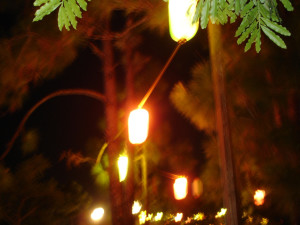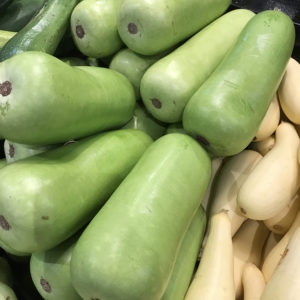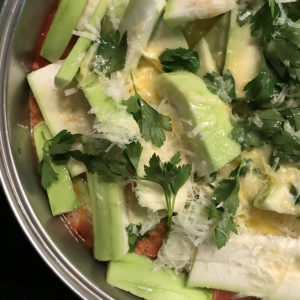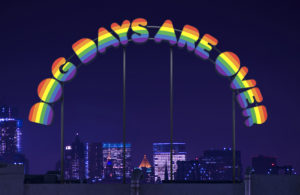We are in the midst of the Dog Days of Summer: they began when July was new, when Sirius, the Dog Star, began rising with the sun. Early astronomers thought the combination of Sirius rising with the sun made for the hottest days of the year. This annual phenomenon remains with us, as it does each year, until the Eleventh of August, when Sirius and the sun once again go their separate ways, thus ending the Dog Days of Summer once more.
It’s been unbearably hot just about everywhere this month. Here, too, the temperatures are running higher than normal: low to mid 90s, rather than the more typical 89 or so, and those few degrees make a big difference. As meals go, it is definitely a time for lighter fare, and today, on the approach to the ancient Roman festival of Neptunalia & Salacia (it falls on July 23), I’ve got the perfect meal to cool things down a bit, and today’s chapter of the Convivio Book of Days comes with a delicious recipe. It’s a Florida recipe that’s born somewhat out of necessity: an attempt to use up some of the local mangoes that are everywhere here come high summer.
And I know the current madness emanating from Tallahassee has not done much for our popularity (I’m with you on that), but let it be known that Florida has delivered some incredible contributions to the national cuisine: We’ve brought you hushpuppies, fried up from cornmeal and chopped onions and beer. We’ve brought you key lime pie, of course. And we’ve even brought you the half & half you pour into your coffee each morning (it was invented right here in Lake Worth at Boutwell Dairy in the early 20th century). Today’s recipe is one you can add to that list. It’s a recipe I adapted from one I picked up from my neighbor Margaret. It’s the perfect accompaniment to fish or chicken, though in this house, it’s always fish, and as such, it is perfect for Neptunalia & Salacia, when the Romans celebrated Neptune, the sea god, and his wife Salacia, goddess of the salty sea. It’s also perfect for any time you need a cooling light supper on an oppressively hot day.
M A N G O W A T E R M E L O N S A L S A
Best served over fish (we like haddock or mahi-mahi or snapper best). Measurements are approximate. The chopping takes some time, but if you make the salsa early in the day, the actual meal comes together at dinnertime in just a few minutes––just as long as it takes for the fish and the rice to cook.
4 mangoes, peeled and pitted
1/2 small round watermelon, preferably seedless
1 small red onion, peeled
2 jalapeño or poblano peppers
fresh cilantro
salt & pepper
Chop, into a small dice, the mangoes, the watermelon, the red onion, and the peppers and combine together in a large bowl. Take care to remove any stray watermelon seeds. I prefer a salsa that is mostly watermelon with almost as much mango, while the red onion and green peppers add their particular colors to the mix in a smaller proportion. Add chopped fresh cilantro to taste, and season with salt and pepper. Chill for at least a few hours, or overnight. Mango Watermelon Salsa will keep in the refrigerator for at least 3 or 4 days. Serve over fish that’s been baked or grilled or pan-fried. Basmati rice makes a nice accompaniment to the fish and salsa. Works equally well over chicken, and perhaps even grilled pork tenderloin.
If you have the luxury of choice, as we do here in Lake Worth, my favorite mangoes for this recipe are Haden mangoes, which we grow here, or Jewel mangoes, which grow at my family’s home nearby. There are some mangoes that have a distinct turpentine taste; I do not like those for this recipe.
Mango season here is quickly coming to a close. Our tree has completed its run for the year, as has Mom’s tree. I’ve heard it said that if you live here in South Florida and you find yourself buying mangoes from the market in summer, then you need to seriously reconsider who you call “friend.” There are so many mango trees here, almost everyone knows someone who has a glut of the fruit in July. They’re delicious, but let’s face it: you can only eat so many. Mango Watermelon Salsa is a most delicious way to get through four of them. Enjoy the meal, as you raise your glasses to each other on Neptunalia & Salacia and every summertime meal.
SUMMER HIGH FIVE SALE!
Enjoy $5 off your order of $35 or more when you use discount code HIGH5 at checkout. Take it to $75 and you’ll earn free domestic shipping, too. Use the deal on Millie’s Tea Towels or on anything else in the shop. Click here to shop! And if you love mangoes, you may equally love our limited edition handmade book, Putting Up Mangoes. It’s a tale I wrote about overwhelming subtropical abundance. You can even use the HIGH5 discount code for $5 off the book!
